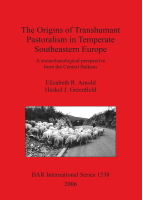Description
BOOK DESCRIPTIONThis book addresses the issue of the temporal origins of transhumant pastoralism in temperate southeastern Europe (northern half of the Balkan Peninsula). In recent years, several hypotheses have been suggested to explain when and why transhumant pastoralism with domestic animals appeared across the southern Mediterranean. Each hypothesis proposes a different point in time when transhumance would appear, ranging from the appearance of the earliest domestic animals (advent of the Early Neolithic), to the appearance of secondary product exploitation (advent of the Post Neolithic), and to the appearance of complex societies (advent of the Iron Age). The hypotheses are tested by examining the tooth remains from three domestic animal taxa (Ovis/Capra, Bos taurus and Sus scrofa) from archaeological sites in the central part of the northern Balkans (also known as the Central Balkans). Data from eleven sites in the region, with statistically sufficient samples and spanning the period from the Early Neolithic through to the Early Iron Age, were tabulated to test the hypotheses. Chapter 1 presents the theoretical background to the research problem and outlines the methodology, techniques and data that are utilized in the research. Chapter 2 provides a definition and discussion of transhumant pastoralism and relevant environmental and ecological parameters. Chapter 3 examines previous research on the origins of transhumant pastoralism in Europe focusing on both the Mediterranean and the northern temperate region ofthe Balkans. The research of Geddes, Halstead and Greenfield are the focus. Chapter 4 introduces the characteristics of the regional environment including topography, climate and vegetation in order to consider the viability of transhumant pastoralism within the northern Balkans. Chapter 5 summarizes the culture history of southeastern Europe from the Neolithic through the Early Iron Age. Aspects of settlement, fauna, and evidence for sedentism and mobility are examined. Chapter 6 describes the methodology to be utilized and details the two chosen techniques, tooth wear and eruption and cementum analysis. Chapter 7 describes the data examined in this investigation. In the chapter, each site is described, including site location, environment and nature ofdeposits. The mandibular and loose teeth remains are quantified by species and by major period. It also describes the thin sectioning data, both the modern comparative collection and the archaeological sample. Chapter 8 presents the results of the data analysis. The first part focuses on the tooth wear and eruption data, examining both production strategies and implications for the transhumant movement of herds. The second part focuses on the thin sectioning results. Chapter 9 presents the final conclusions regarding the data and discusses their implication in terms of the origins of transhumant pastoralism in the northern Balkans.











